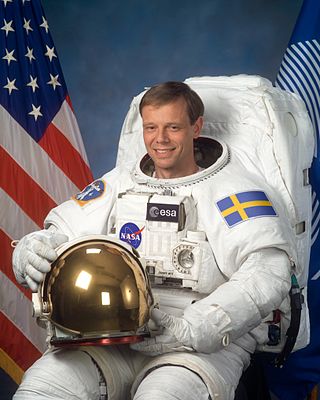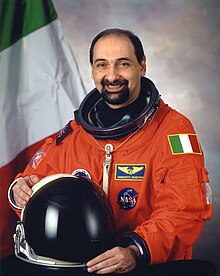
Space Shuttle Atlantis is a retired Space Shuttle orbiter vehicle which belongs to NASA, the spaceflight and space exploration agency of the United States. Atlantis was manufactured by the Rockwell International company in Southern California and was delivered to the Kennedy Space Center in Eastern Florida in April 1985. Atlantis is also the fourth operational and the second-to-last Space Shuttle built. Its maiden flight was STS-51-J made from October 3 to 7, 1985.

Spacelab was a reusable laboratory developed by European Space Agency (ESA) and used on certain spaceflights flown by the Space Shuttle. The laboratory comprised multiple components, including a pressurized module, an unpressurized carrier, and other related hardware housed in the Shuttle's cargo bay. The components were arranged in various configurations to meet the needs of each spaceflight.

Ulf Dietrich Merbold is a German physicist and astronaut who flew to space three times, becoming the first West German citizen in space and the first non-American to fly on a NASA spacecraft. Merbold flew on two Space Shuttle missions and on a Russian mission to the space station Mir, spending a total of 49 days in space.

Robert Brent "Bob" Thirsk, is a Canadian retired engineer and physician, and a former Canadian Space Agency astronaut. He holds the Canadian record for the most time spent in space. He became an officer of the Order of Canada (OC) in 2013 and was named to the Order of British Columbia (OBC) in 2012.

Hans Wilhelm Schlegel is a German physicist, a former ESA astronaut, and a veteran of two NASA Space Shuttle missions.

Claude Nicollier is the first astronaut from Switzerland. He has flown on four Space Shuttle missions. His first spaceflight (STS-46) was in 1992, and his final spaceflight (STS-103) was in 1999. He took part in two servicing missions to the Hubble Space Telescope. During his final spaceflight he participated in a spacewalk, becoming the first European Space Agency astronaut to do so during a Space Shuttle mission. In 2000 he was assigned to the Astronaut Office Extravehicular Activity Branch, while maintaining a position as Lead ESA Astronaut in Houston. Nicollier retired from ESA in April 2007.

Andrew Michael "Andy" Allen is a retired American astronaut. A former Marine aviator and lieutenant colonel, he worked as a test pilot before joining NASA in 1987. He flew three Space Shuttle missions before retiring in 1997.

Jeffrey Alan Hoffman is an American former NASA astronaut and currently a professor of aeronautics and astronautics at MIT.

Brigadier Roberto Vittori, OMRI is an Italian Air Force officer and an ESA astronaut. After graduating from the Italian Accademia Aeronautica in 1989, Vittori flew in the Italian Air Force. He then trained as a test pilot in the United States.

The Italian Space Agency is a government agency established in 1988 to fund, regulate and coordinate space exploration activities in Italy. The agency cooperates with numerous national and international entities who are active in aerospace research and technology.

A Multi-Purpose Logistics Module (MPLM) is a large pressurized container that was used on Space Shuttle missions to transfer cargo to and from the International Space Station (ISS). Two MPLMs made a dozen trips in the Shuttle cargo bay and initially berthed to the Unity module and later the Harmony module on the ISS. From there, supplies were offloaded, and finished experiments and waste were reloaded. The MPLM was then reberthed in the Shuttle for return to Earth. Three modules were built by the Italian Space Agency (ASI): Leonardo, Raffaello, and Donatello.

Thomas Arthur Reiter is a retired European astronaut and is a Brigadier General in the German Air Force currently working as ESA Interagency Coordinator and Advisor to the Director General at the European Space Agency (ESA). He was one of the top 25 astronauts in terms of total time in space. With his wife and two sons he lives near Oldenburg in Lower Saxony.

Arne Christer Fuglesang is a Swedish physicist and an ESA astronaut. He was first launched aboard the STS-116 Space Shuttle mission on 10 December 2006, making him the first Swedish citizen in space.

The Minus Eighty-Degree Laboratory Freezer for ISS (MELFI) is a European-built experiment storage freezer for the International Space Station. It comprises four independent dewars which can be set to operate at different temperatures. Currently temperatures of −80 °C, −26 °C, and +4 °C are used during on-orbit ISS operations. Both reagents and samples will be stored in the freezer. As well as storage the freezer is designed to be used to transport samples to and from the ISS in a temperature controlled environment. The total capacity of the unit is 300 litres.

Major Paolo Angelo Nespoli is an Italian astronaut and engineer of the European Space Agency (ESA). In 2007, he first traveled into space aboard the Space Shuttle Discovery as a mission specialist of STS-120. In December 2010 he again traveled into space aboard the Soyuz TMA-20 spacecraft as an Expedition 26/27 flight engineer. Nespoli's third spaceflight was on board Soyuz MS-05, which launched in July 2017 for Expedition 52/53. He was also the European Space Agency's oldest active astronaut prior to his retirement in 2019.
The European Astronaut Corps is a unit of the European Space Agency (ESA) that selects, trains, and provides astronauts as crew members on U.S. and Russian space missions. The corps has 13 active members, able to serve on the International Space Station (ISS). The European Astronaut Corps is based at the European Astronaut Centre in Cologne, Germany. They can be assigned to various projects both in Europe or elsewhere in the world, at NASA Johnson Space Center or Star City.

Akihiko Hoshide is a Japanese engineer, JAXA astronaut, and former commander of the International Space Station. On August 30, 2012, Hoshide became the third Japanese astronaut to walk in space.

The Johannes Kepler ATV, or Automated Transfer Vehicle 002 (ATV-002), was an uncrewed cargo spacecraft built to resupply the International Space Station (ISS). It was launched on February 16, 2011 by the European Space Agency (ESA). Johannes Kepler carried propellant, air and dry cargo weighing over 7,000 kilograms (15,000 lb), and had a total mass of over 20,000 kilograms (44,000 lb), making it, at the time, the heaviest payload launched by the ESA. The spacecraft was named after the 17th-century German astronomer Johannes Kepler.

NASA Astronaut Group 9 was a group of 19 NASA astronauts announced on May 29, 1980, and completed their training by 1981. This group was selected to supplement the 35 astronauts that had been selected in 1978, and marked the first time that non-Americans were trained as mission specialists with the selections of ESA astronauts Claude Nicollier and Wubbo Ockels. In keeping with the previous group, astronaut candidates were divided into pilots and mission specialists, with eight pilots, eleven mission specialists, and two international mission specialists within the group.

The European contribution to the International Space Station comes from 10 members of the European Space Agency (ESA) and amounts to an 8% share in the programme. It consists of a number of modules in the US Orbital Segment, ATV supply ships, launchers, software and €8 billion.






















